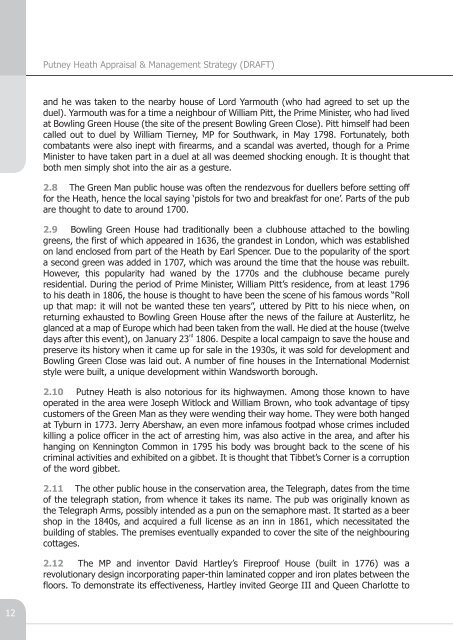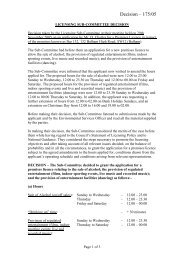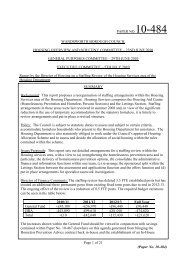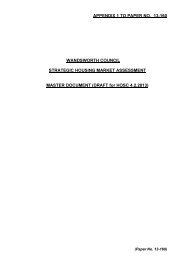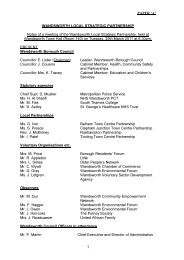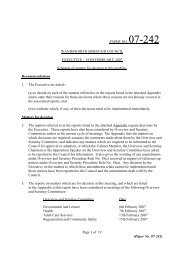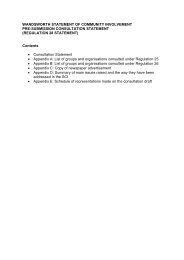Putney Heath Appraisal & Management Strategy (DRAFT)
Putney Heath Appraisal & Management Strategy (DRAFT)
Putney Heath Appraisal & Management Strategy (DRAFT)
Create successful ePaper yourself
Turn your PDF publications into a flip-book with our unique Google optimized e-Paper software.
12<br />
<strong>Putney</strong> <strong>Heath</strong> <strong>Appraisal</strong> & <strong>Management</strong> <strong>Strategy</strong> (<strong>DRAFT</strong>)<br />
and he was taken to the nearby house of Lord Yarmouth (who had agreed to set up the<br />
duel). Yarmouth was for a time a neighbour of William Pitt, the Prime Minister, who had lived<br />
at Bowling Green House (the site of the present Bowling Green Close). Pitt himself had been<br />
called out to duel by William Tierney, MP for Southwark, in May 1798. Fortunately, both<br />
combatants were also inept with firearms, and a scandal was averted, though for a Prime<br />
Minister to have taken part in a duel at all was deemed shocking enough. It is thought that<br />
both men simply shot into the air as a gesture.<br />
2.8 The Green Man public house was often the rendezvous for duellers before setting off<br />
for the <strong>Heath</strong>, hence the local saying ‘pistols for two and breakfast for one’. Parts of the pub<br />
are thought to date to around 1700.<br />
2.9 Bowling Green House had traditionally been a clubhouse attached to the bowling<br />
greens, the first of which appeared in 1636, the grandest in London, which was established<br />
on land enclosed from part of the <strong>Heath</strong> by Earl Spencer. Due to the popularity of the sport<br />
a second green was added in 1707, which was around the time that the house was rebuilt.<br />
However, this popularity had waned by the 1770s and the clubhouse became purely<br />
residential. During the period of Prime Minister, William Pitt’s residence, from at least 1796<br />
to his death in 1806, the house is thought to have been the scene of his famous words “Roll<br />
up that map: it will not be wanted these ten years”, uttered by Pitt to his niece when, on<br />
returning exhausted to Bowling Green House after the news of the failure at Austerlitz, he<br />
glanced at a map of Europe which had been taken from the wall. He died at the house (twelve<br />
days after this event), on January 23 rd<br />
1806. Despite a local campaign to save the house and<br />
preserve its history when it came up for sale in the 1930s, it was sold for development and<br />
Bowling Green Close was laid out. A number of fine houses in the International Modernist<br />
style were built, a unique development within Wandsworth borough.<br />
2.10 <strong>Putney</strong> <strong>Heath</strong> is also notorious for its highwaymen. Among those known to have<br />
operated in the area were Joseph Witlock and William Brown, who took advantage of tipsy<br />
customers of the Green Man as they were wending their way home. They were both hanged<br />
at Tyburn in 1773. Jerry Abershaw, an even more infamous footpad whose crimes included<br />
killing a police officer in the act of arresting him, was also active in the area, and after his<br />
hanging on Kennington Common in 1795 his body was brought back to the scene of his<br />
criminal activities and exhibited on a gibbet. It is thought that Tibbet’s Corner is a corruption<br />
of the word gibbet.<br />
2.11 The other public house in the conservation area, the Telegraph, dates from the time<br />
of the telegraph station, from whence it takes its name. The pub was originally known as<br />
the Telegraph Arms, possibly intended as a pun on the semaphore mast. It started as a beer<br />
shop in the 1840s, and acquired a full license as an inn in 1861, which necessitated the<br />
building of stables. The premises eventually expanded to cover the site of the neighbouring<br />
cottages.<br />
2.12 The MP and inventor David Hartley’s Fireproof House (built in 1776) was a<br />
revolutionary design incorporating paper-thin laminated copper and iron plates between the<br />
floors. To demonstrate its effectiveness, Hartley invited George III and Queen Charlotte to


